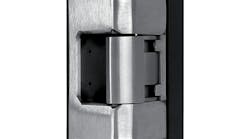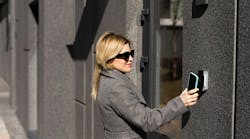What once was seen as luxurious and tech-savvy is now many homeowners’ reality — the smart home.
In fact, market researcher Statista forecasts the number of smart homes in the world to surpass the 350 million mark by 2023. Another report by Parks Associates reveals that more than 12 million U.S. households use a smart door lock.
With the smart-home market — and, correspondingly, smart locks — maintaining stride on a path of growth and innovation, locksmiths should develop a level of fluency around smart-lock installation and, ultimately, the steps necessary to integrate a customer’s smart home properly.
In this report, we’ll discuss how to perform a smart installation for residents.
Create a Checklist
Before screws are loosened and tools come out to play, you should take an inventory of the home at hand and decide what components are necessary to integrate a smart lock successfully. Confirm that the door and its frame are properly flush. Smart locks work best when doors are aligned, because proper alignment allows the mechanical sets to function smoothly and frees them from binding.
Pushing or pulling on the door a little to align the deadbolt might be acceptable for a mechanical set. However, doing that most likely will prevent a smart lock’s remote operations from working, so make sure the door is aligned before you install the lock.
Also, be sure to consider fire ratings, particularly when you work in a multifamily environment. The lock rating must match the door label to ensure safety for all residents.
Besides the physical state of the door, it’s important to understand whether the customer has set up a smart-home ecosystem. If so, determine the type of hub in use and confirm the preferred locations of the different devices. This will save you time on the back end. Although these details might seem trivial, they will be helpful after installation and integration take place.
Replace or Retrofit
After the preparation comes the fun part — installation! If the door alignment was checked properly before installation and it all checked out, the process should be fairly straightforward. Most smart locks are easy enough for consumers to install themselves. For professionals, the goal is more to ensure the installation is perfectly clean and bind-free, which can be more difficult for the average user to achieve.
For homeowners and customers who aren’t concerned about keeping a set of keys, a smart lock that has a key-free full deadbolt replacement is ideal. This eliminates the necessity to have keys altogether. However, keyed smart locks can be repinned easily by using the tools any locksmith already has.
Installation is simple and requires everyday tools, such as a screwdriver or drill, pencil, tape measure and level, to secure accurate face bore, cross bore and strike pocket measurements. For those who favor maintaining keys as another form of entry, a keyed deadbolt smart lock is a great option and requires a similar installation process.
However, if the customer is a renter or landlord, consider selecting a smart lock that has retrofit capabilities. In this configuration, the smart lock fits over the interior part of the deadbolt, which leaves the exterior unchanged. This allows renters and landlords to retain their current keys and maintain the overall look of the door’s exterior, while still gaining smart-lock capabilities.
The most important thing to remember when you work with aesthetic-focused clients is to check for clearances around the lock and confirm that the design of the lock allows a retrofit to be used. For example, a full escutcheon lock design wouldn’t work with a retrofit lock, and only more-modern mortise locks are able to be retrofitted.
Integrate the Home
After the physical installation of the smart lock is complete, it’s time to help customers integrate the lock with their smart home. If the customer already has smart-home devices installed in their home, check what network protocols are attached.
Many smart locks work with common DIY systems, such as Amazon Alexa and Google Home via Wi-Fi, but more-complex systems might run over Z-Wave or Zigbee or have professionally installed networks, such as Savant and Control4. Consult the customer on how they want to integrate their smart lock into their system and come ready with appropriate recommendations for brands, reputation and longevity for each system.
If the customer is new to smart-home technology and eager to create an integrated smart-home system from scratch, start by focusing on everyday areas — lights, locks and thermostats. These technologies integrate seamlessly and can help to create many users’ first smart-home experience as they create nighttime and wake-up habits.
Set routines so when the customer locks up for the night, lights automatically dim or turn off and the thermostat turns down to a cool sleeping temperature. Teaching users these automations help them to build confidence and feel as though their investment is worthwhile (while trusting your expertise, which could lead to future business).
Note: One of the most common issues when integrating a smart home is confirming that the wireless range is sufficient. The easiest way to troubleshoot this is to take the lock on a walk.
Take the lock off the door and move it closer to the wireless hub or gateway to secure the connection between the two devices. If moving the wireless hub or gateway closer isn’t an option, an easy fix is to add an appropriate range extender to the setup.
Now What?
After you install and integrate the customer’s smart-home system, you have one last job — ensuring the customer understands how to optimize their experience in their new smart home.
First, hone in on convenience. That’s one of the top reasons why customers adopt smart locks in the first place. Emphasize that the customer can ditch traditional keys and operate their front door from their phone or the lock’s keypad — no hide-a-keys or frantic “I forgot to lock the door” moments again.
Furthermore, home access can be a breeze when welcoming guests for the weekend, letting in dog walkers or coordinating home-repair contractors. Simply share unique keypad codes or grant access through the smart lock’s mobile app.
Second, remind the customer about the security benefits. By using keyless smart locks, they won’t have to worry about stolen or copied keys, and through a Wi-Fi hub or module, they can have 24/7 visibility over their front door. This can be particularly helpful for customers who want to watch for their kids to return from school or make sure the dog walker comes on time. Users can get notifications every time the door opens or closes.
Final Thoughts
The smart-home landscape is ever-changing, and there constantly are new trends and innovations. For example, Matter, the newest interoperability standard, has arrived. It boasts easy setup, great wireless connectivity and long battery life. Plus, in many cases, customers already might have a Matter-compatible gateway in their home.
The new Matter standard will be marketed heavily by big tech companies Amazon, Apple and Google. That will result in customers gaining interest in this new standard, so take some time to become familiar with what it does, how it works and how it will affect smart-home decisions. Smart-lock companies have pledged support of the Matter standard.
We expect the demand for smart homes only will continue to grow as more consumers view this technology as convenient, easy to use and accessible. Smart locks deliver an accessible gateway to the smart-home experience, and locksmiths have a unique opportunity to help to modernize front doors for many.
Garrett Lovejoy is vice president of product management at ASSA ABLOY.





